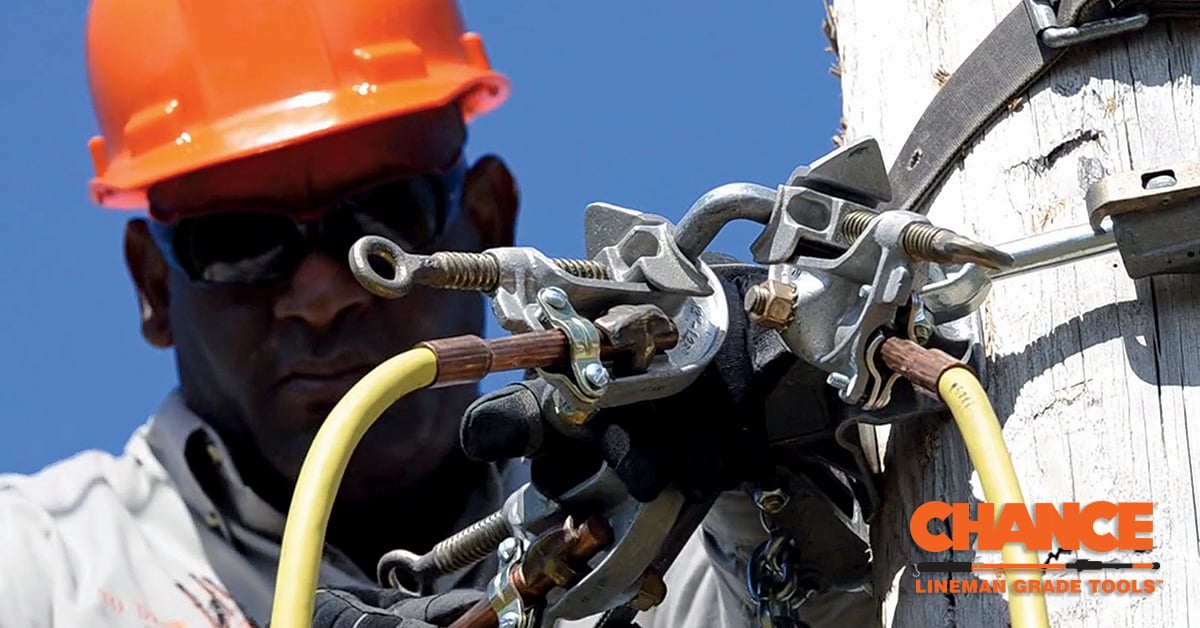In the event of a fault, current will seek any and every available path to ground during de-energized and grounded line maintenance. The goal of personal protective grounding is to have the parallel personal protective ground set path have the lowest possible resistance so the vast majority of the fault current will flow thought it, rather than the line worker’s body. Understanding industry guidelines for temporary personal protective grounding practices and equipotential zones (EPZ) is critical to the safety of line workers.
Temporary personal protective grounding equipment should be tested periodically. Testing frequency is determined by the utility/user based on company policy, equipment use, environment, work conditions, storage and handling practices, and care and maintenance practices. The CHANCE® factory recommendation is to require retesting of all grounding sets at a minimum of every 12 months.
Utilities should review their temporary personal protective grounding practices and procedures periodically per company policy, whenever there is a change in their system, a change in OSHA guidelines, or changes in industry standards such as IEEE or ASTM.
Contact the CHANCE team for a free consultation of your company’s equipotential and grounding equipment and practices.
Considerations for Proper Personal Protective Temporary Grounding
Adequate Equipment for Temporary Grounding
When selecting a properly-rated temporary ground set, the maximum available fault current, the duration of the fault current, and the X/R (asymmetry) for the worksite must be taken into account with the lowest rated component determining the rating of the set.
Equipment Care and Maintenance
Recent updates to OSHA 1910.269(n) and 1926.962 have emphasized the responsibility of the employer to ensure their personal protective grounding equipment and practices are adequate to protect employees from hazardous differences in electrical potential. One important aspect that is often overlooked is the care and maintenance of the grounding equipment. Learn more in our Care and Maintenance of Personal Protective Equipment blog.
Other Important Considerations for Personal Protective Temporary Grounding:
OSHA Industry Guidelines
OSHA 1910.296(n) has a lot to say about personal protective temporary grounding that we review below. You can learn more about these guidelines here.
OSHA Standard 1910.269(n)(3)
“Temporary protective grounds shall be placed at such locations and arranged in such a manner as to prevent each employee from being exposed to hazardous differences in electrical potential.”
OSHA Standard 1910.269(n)(2)
“For any employee to work transmission and distribution lines or equipment as deenergized, the employer shall ensure that the lines or equipment are deenergized under the provisions of paragraph (m) of this section and shall ensure proper grounding of the lines or equipment as specified in paragraphs (n)(3) through (n)(8) of this section.”
OSHA 1910.269 APP C Section III.D.II
“Wood poles are conductive objects. The poles can absorb moisture and conduct electricity, particularly at distribution and transmission voltages. Consequently, the employer must either: (1) Provide a conductive platform, bonded to a grounding cable, on which the worker stands or (2) use cluster bars to bond wood poles to the grounding cable. The employer must ensure that employees install the cluster bar below, and close to, the worker’s feet. The inner portion of the wood pole is more conductive than the outer shell, so it is important that the cluster bar be in conductive contact with a metal spike or nail that penetrates the wood to a depth greater than or equal to the depth the worker’s climbing gaffs will penetrate the wood. For example, the employer could mount the cluster bar on a bare pole ground wire fastened to the pole with nails or staples that penetrate to the required depth. Alternatively, the employer may temporarily nail a conductive strap to the pole and connect the strap to the cluster bar.”
Consultation and Training Resources
Proper training of linemen on temporary personal protective grounding is critical to their safety and a duty which the CHANCE Lineman Grade Tools team takes very seriously. We offer training resources, consultations, videos, and articles to assist you and your utility in navigating and understanding how to keep everyone safe while performing deenergized and grounded line maintenance.
In-Person Training
Our team has been conducting live line training and customers sites around the world since 1937. Our experienced team of journeymen linemen can customize training topics to suit the needs of your team. Contact our CHANCE Demonstrator team to learn more about in-person, paid training.
Encyclopedia of Grounding
Considered the industry-leading publication of information about grounding, the CHANCE Encyclopedia of Grounding is a comprehensive guide to temporary grounding best practices. Download it today.
Supporting Articles
Our team strives to publish the latest information about temporary grounding best practices. Check out the articles here and be sure to subscribe to have the latest information delivered to your inbox.
Video Resources
Start with this overview of personal protective grounding.
Schedule a Consultation
Meet with the CHANCE safety experts to learn if your temporary grounding equipment and practices comply with safety standards. Our team offers product testing, equipment selection recommendations, and analysis of your utility's current practices. Contact our team to get started.

